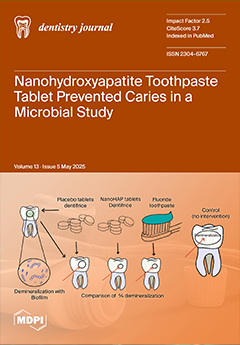Objectives: To examine the effects of surface treatments on the color stability, surface roughness, surface gloss, and wettability of monolithic polychromatic material jetting (MJT) 3D-printed denture material.
Material and Methods: Twenty-one color variants of the same denture material (TrueDent; Stratasys, Eden, MN, USA)
[...] Read more.
Objectives: To examine the effects of surface treatments on the color stability, surface roughness, surface gloss, and wettability of monolithic polychromatic material jetting (MJT) 3D-printed denture material.
Material and Methods: Twenty-one color variants of the same denture material (TrueDent; Stratasys, Eden, MN, USA) underwent two surface treatments (polishing only or polishing and glazing), creating 42 study groups with a total of 420 samples (n = 10 per group). The samples were manufactured using a PolyJet 3D printer (J5 DentaJet; Stratasys, Eden, MN, USA), a type of MJT 3D printer. Color measurements were taken with a digital spectrophotometer before and after the surface treatments, and quantitative color differences (ΔE
00 and ΔC*) were calculated using the CIE2000 system. Comparisons of ΔE
00 were made against the 50%:50% acceptability threshold (AT) of 1.8 and the 50%:50% perceptibility threshold (PT) of 0.8 for tooth shade, as well as the 50%:50% PT of 1.72 and the 50%:50% AT of 4.08 for gingival (pink) shade. After surface treatment, the gloss was measured using a glossmeter, surface roughness was measured with optical profilometry, and wettability was measured by contact angle measurements using an optical tensiometer. The significance of surface treatment on color changes for each color variant was evaluated using one-sided, one-sample
t-tests against the AT and PT. The effects of surface treatment on surface gloss, surface roughness, contact angle, and ΔC* were analyzed using
t-tests for each color variant. Pairwise comparisons between groups were made using Fisher’s Protected Least Significant Differences (α = 0.05).
Results: In most cases, glazing caused the color change (ΔE
00) to exceed the AT and PT, with a few exceptions. Most materials exhibited a more vibrant (more saturated) appearance and statistically higher chroma, with glazed surface treatments compared to polished ones, though there were some exceptions. For all materials, the glazed samples had significantly higher gloss units than the polished ones (
p < 0.0001). Additionally, all materials showed significantly higher surface roughness in glazed samples compared to polished ones (
p < 0.0001 for most). The polished samples had significantly higher contact angles (
p < 0.0001 for most).
Conclusions: Surface treatments significantly influenced the color, surface gloss, surface roughness, and wettability of MJT 3D-printed denture materials. Glazing led to increased chroma and gloss and produced more hydrophilic surfaces, although it also increased surface roughness. These results highlight the importance of surface treatment selection in optimizing the clinical performance of MJT-fabricated dentures.
Full article






